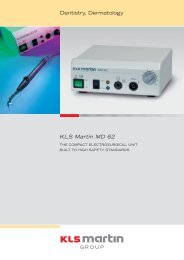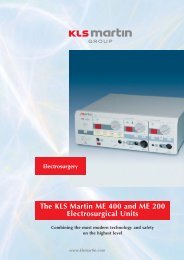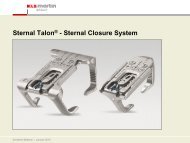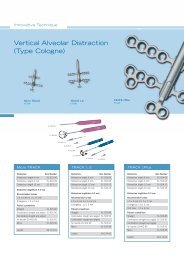Hand Surgery HBS
Hand Surgery HBS
Hand Surgery HBS
Sie wollen auch ein ePaper? Erhöhen Sie die Reichweite Ihrer Titel.
YUMPU macht aus Druck-PDFs automatisch weboptimierte ePaper, die Google liebt.
Operationstechnik<br />
Surgical Technique<br />
26-370-03 26-350-01<br />
26-370-09<br />
Schritt 1: Bohrhülse<br />
Die Bohrhülse wird mit dem <strong>Hand</strong>griff zusammenmontiert<br />
(26-370-03 in 26-350-01)<br />
und anschließend sorgsam auf dem zu<br />
fixierenden Knochen positioniert.<br />
Die zwei Einkerbungen auf der Bohrhülse<br />
ermöglichen eine nahe oder weiter entfernte<br />
Positionierung des <strong>Hand</strong>griffs zum proximalen<br />
Fragment.<br />
Achtung:<br />
Alles Weichteilgewebe, welches den Knochen<br />
bedeckt, muss sorgfältig entfernt werden,<br />
so dass die Spitzen der Bohrhülse fest im<br />
Knochen verankert werden können. Nur so<br />
lassen sich ungewollte Verschiebungen der<br />
Bohrhülse vermeiden und eine spätere<br />
exakte Längenkalibrierung sicherstellen.<br />
Schritt 2: Vorübergehende Drahtfixierung<br />
(optional)<br />
Nun wird ein 1 mm starker Fixationsdraht<br />
(26-351-00) durch eines der sechs Löcher<br />
im Haltering des <strong>Hand</strong>griffs eingeführt. Er<br />
kann unter Bildwandlerkontrolle durch den<br />
Fraktur- bzw. Fusionssitus hindurchgeführt<br />
werden, damit bei Einführung der Schraube<br />
eine gute Reduktion gegeben ist. Nachdem<br />
der Draht optimal positioniert ist, kann das<br />
überstehende Ende entweder umgebogen<br />
oder abgeschnitten werden, damit es den<br />
Zugang zur Bohrhülse nicht behindert.<br />
Nach Abschluss des Operationsverfahrens<br />
wird der Draht entweder wieder entfernt<br />
oder bündig mit der Knochenoberfläche<br />
abgeschnitten und als 2-Punkt-Fixation in<br />
Position gelassen.<br />
Schritt 3: Bohren<br />
Sobald die Fraktur entsprechend reponiert ist<br />
und die Bohrhülse sich in der korrekten Position<br />
befindet, wird der Bohrer (26-370-09)<br />
eingebracht. Dies kann manuell mit dem<br />
Bohrhandgriff (26-350-11) oder maschinell<br />
geschehen.<br />
Die Einbringung des Bohrers unter Bildwandlerkontrolle<br />
gewährleistet eine exakte<br />
Positionierung. Sobald der Bohrer die erforderliche<br />
Tiefe erreicht hat, kann man an der<br />
Messskala die korrekte Schraubenlänge<br />
ablesen.<br />
Step 1: Drill guide<br />
The drill guide is assembled (26-370-03<br />
into 26-350-01) and is then carefully positioned<br />
on the bone to be fixed. The two<br />
notches on the drill guide enable either a<br />
closer or more distant positioning of the<br />
handle on the proximal fragment.<br />
ATTENTION:<br />
It is important to carefully remove any soft<br />
tissue overlying the bone, since the points<br />
on the tip of the guide should be engaged<br />
in bone to ensure accurate length calibration.<br />
Step 2: Temporary fixation wire<br />
(optional)<br />
A 1-mm fixation wire (26-351-00) may be<br />
passed through one of the six peripheral<br />
holes of the collar of the guiding handle<br />
(26-350-01); this pin is advanced accross<br />
the fracture/fusion site under x-ray control,<br />
in order to maintain a good reduction<br />
during insertion of the screw. When its<br />
position is judged satisfactory, the protruding<br />
end of the fixation wire should be bent<br />
or cut short, so that it does not obstruct<br />
access to the guide. At the end<br />
of the procedure it is either removed, or<br />
else cut flush to the bone surface and<br />
left in position to provide 2-point fixation.<br />
Step 3: Drilling<br />
Once the fracture is accurately repositioned<br />
and the drill guide is in correct position,<br />
the drill (26-370-09) is inserted, either by<br />
hand or preferably, using a suitable power<br />
driver.<br />
Insertion of the drill under x-ray control<br />
(image intensifier) ensures precise<br />
positioning. Once the drill has reached<br />
the required depth, the calibration is read,<br />
in order to determine the correct lenght<br />
of the implant.






